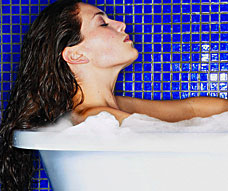Is your bubble bath safe?
(dailymail)
Updated: 2006-09-12 14:23
 |
Large Medium Small |
 Bath foam that triggers headaches. Shampoo full of cancer-causing chemicals. And shower gel that attacks your skin. As experts warn of the chemicals in our toiletries, we reveal the health hazards in your bathroom cabinet.
Bath foam that triggers headaches. Shampoo full of cancer-causing chemicals. And shower gel that attacks your skin. As experts warn of the chemicals in our toiletries, we reveal the health hazards in your bathroom cabinet.
Pat Thomas makes sense of the often impenetrable labels, and reveals the ingredients' potentially devastating effects on our health.
Bath products
These days, most of us don't use soap in the shower or bath. Instead, we lather up with bath foams, shower gels, facial washes and scrubs, all of which rely on complex detergents — often the same ones used in heavy industry — to wash away simple dirt.
The difference between soap and detergent is like the difference between cotton and nylon. Soap and cotton are produced from natural products by relatively small modification.
Detergents and nylon are produced entirely in a chemical factory. There is no difference between the detergents in your household cleaning products and those you use in your bath. It is simply a matter of concentration.
Bubble baths, which are highly fragranced, have the greatest potential to cause skin irritation, allergic skin reactions and headaches. In the U.S., they carry a health warning alerting users to the possibility of skin irritation and urinary tract infections.
Body washes essentially contain the same basic ingredients as bubble bath. Soaking in any bath product will prolong its contact with your skin, increasing the risk that chemicals will be absorbed. Both bubble baths and shower gels have the potential to penetrate the skin and lungs.
Your bubble bath is likely to contain potentially irritating detergents like sodium laureth sulphate and cocami-dopropyl betaine (the latter is also a penetration enhancer, allowing other chemicals to be more easily absorbed); preservatives such as tetrasodium EDTA, a potential irritant; and methylchloroisothiazolinone (both potential mutagens — substances that speed up gene mutation).
If it contains cocamide EDTA (or similar compounds ending with DEA, TEA or MEA) along with formaldehyde-forming substances such as bronopol, DMDM hydantoin, diazo-lidinyl urea, imidazolidinyl urea and quaternium-15, it is likely to contain cancer-causing nitrosamines. Studies show up to 93 per cent of toiletries and cosmetics contain these compounds.
Healthier options
Avoid bubble baths altogether and limit your use of shower gels. Stick to plain old soap instead. Vegetable oil and glycerine soaps are best. They foam beautifully and are made from enriching oils such as coconut, hemp and olive. They are usually unfragranced or scented with essential oils (check the label).
Toothpaste
The problems of dental decay and gum disease are very real and affect more than just the mouth. Gum disease is strongly linked to other conditions such as heart disease. Indeed, your risk of developing heart disease is higher if you have poor oral health than if you smoke and have high cholesterol.
Poor oral health also raises your risk of stroke, osteoporosis, respiratory diseases and diabetes. Several of the 'active' ingredients in toothpaste are worrying. Widely used industrial-strength detergent sodium lauryl sulphate (SLS) is a suspected gastrointestinal or liver poison.
There is also concern that by stripping away the protective mucous membrane of the mouth, SLS could increase the incidence of mouth ulcers, and may be involved in an increased risk of oral cancer.
Triclosan is one of the most common antibacterial agents used in toothpaste. There is evidence that it can help reduce plaque build-up but, like SLS, triclosan is an irritant. The widespread use of triclosan is associated with a rise in 'super bugs' — bacteria that are resistant to many kinds of antiseptics and antibiotics.
Abrasives commonly found in toothpaste, such as silica, are also potentially harmful. Fine granules can build up under the surface of the gums, causing granulomas — small nodules of inflamed tissue, which may leave gums vulnerable to infection.
Fluoride
But the most controversial ingredient in toothpaste is fluoride. Many of us buy fluoride-containing toothpastes in the belief they will protect our teeth. There is, according to Pat Thomas, little convincing scientific evidence to support this.
She says fluoride is in fact a poison — there is enough fluoride in the average-sized tube of family toothpaste to kill a small child if ingested. For this reason, she says, the American Food and Drug Administration and the Swedish National Food Administration require toothpaste containing fluoride to be labelled with a 'poison' warning.